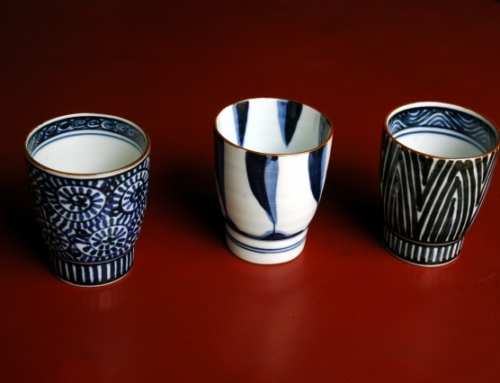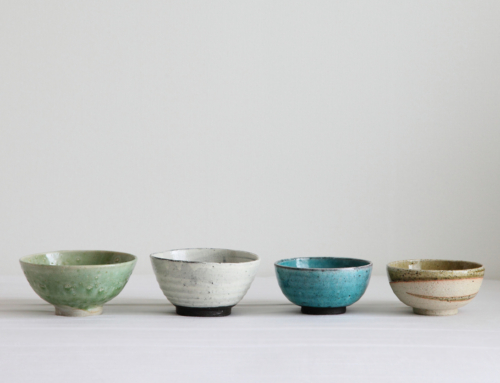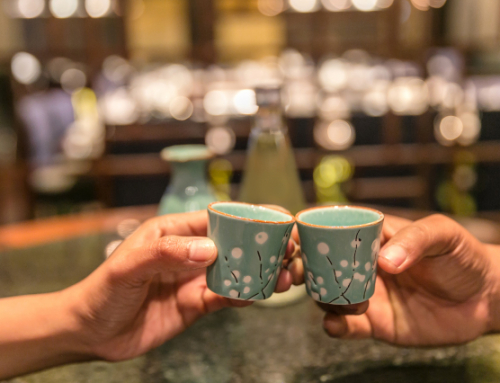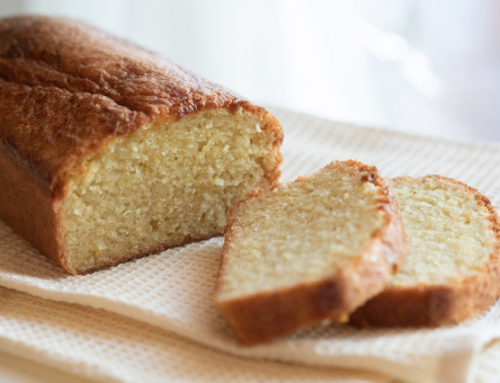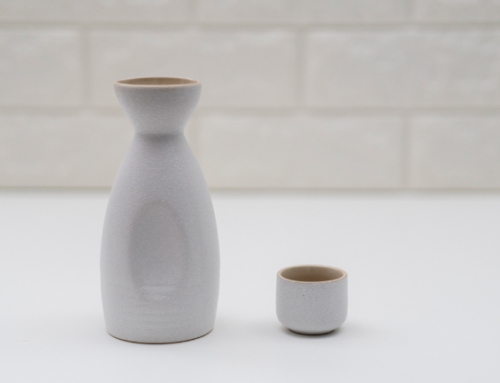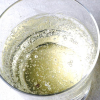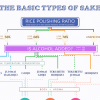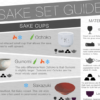Contents
- 1 First, the differences in materials
- 2 Pottery
- 3 Glass
- 4 Lacquer
- 5 Tin
- 6 Selection by the amount of Sake
- 7 Selection by the opening of the sake vessels
- 8 Selection by the shape of the sake vessel
- 9 The Difference in Ochoko and Guinomi
- 10 The Difference between tokkuri and katakuchi
- 11 The Enjoyment of a different type of sake vessel
- 12 Off Topic: How to drink Mokkiri
- 13 There are no rules on how to drink
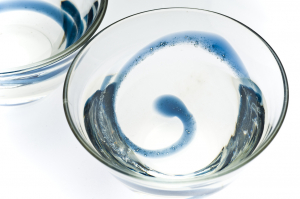
When searching for a delicious Sake to drink, many will try different types of Sake for comparison. From dry to sweet, Seishu and Nigori Sake, Sake has many types. Though it is fun to discover your type, it can be overwhelming as well.
However, to enjoy Sake, there is something besides the Sake to consider. This is sake vessel selection. We mean, it is fun to select sake vessels to enjoy Sake more. What type of sake vessel is appropriate for this or that type of Sake? Let us explain in more details.
- First, the differences in materials
- Pottery
- Glass
- Lacquer
- Tin
- Selection by the amount of Sake
- Selection by the opening of the sake vessels
- Selection by the shape of the sake vessel
- The Difference in Ochoko and Guinomi
- The Difference between tokkuri and katakuchi
- The Enjoyment of a different type of sake vessel
- Off Topic: How to drink Mokkiri
- There are no rules on how to drink
First, the differences in materials
Let us explain how to select sake vessels which will give you the ultimate enjoyment from Sake. First, let us consider the material. There is pottery, which is easy to imagine; glass; lacquer, which common in Asian countries; and for a little more luxury, tin. Let’s examine the difference in these materials.
Pottery
Though it is expressed just as “pottery,” this includes pottery pieces as well as ceramics. So, first, let us explore the pottery sake vessels in the pottery category.
For Sake from pottery sake vessels, our recommendation would be deep flavored Junmai or Yamahai. Because pottery sake vessels have a thickness, the taste from the Sake will feel softer.
When selecting pottery, even deep flavored Sake will not be awkward and become easy to drink. When drinking Sake such as deep flavored Sake, if you prefer savoring the Sake by sipping slowing over a period of time, we recommend pottery sake vessels.
On the other hand, ceramic sake vessels are better suited for lighter Sake. To help remember the sake vessels and their relation to Sake flavor, place ceramic sake vessels after our next material explanation, the glass sake vessel.
Glass
Then, what type of Sake is suitable for glass sake vessels? The answer is Ginjo and Daiginjo, Sake with a delicate flavor are suited best for glass sake vessels. In the case of glass sake vessels, the majority use thin glass.
Therefore, even for delicate Sake such as Ginjo, it is possible to taste all the subtle, intricate flavors when using glass sake vessels. The sensation in your mouth, combined with the sharpness of the Sake allows the best portions of Ginjo to be experienced.
Lacquer
It may be difficult to imagine drinking Sake from a lacquer sake vessel. However, if you have an opportunity to enjoy Sake from a lacquer sake vessel, we recommend trying Koshu, vintage sake. The deep flavored, tinted sake slides smoothly off of lacquer sake vessels.
Not only the taste, lacquer sake vessels are also a treat for the eyes. But do not forget the unique flavor of Sake which can be drawn from the lacquer sake vessels. Unlike pottery or glass, the slick lacquerware sake vessels allow the complex koshu sake to be enjoyed smoothly.
Tin
This is also a material not commonly used in sake vessels. However, from the olden ages, it has been said that pouring Sake into a tin sake vessel softens the Sake. The ion component of the tin must be the contributor to the mellow flavor.
Though we cannot comment on the authenticity, Kimoto-type with its strong acidity or even cold sake is transformed into an easy to drink, mellow flavor. This material’s sake vessels will allow you to enjoy the basic taste of Sake.
Selection by the amount of Sake
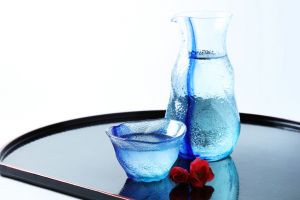
Sake and its temperature have a deep relationship which cannot be severed. For this reason, the capacity of the sake vessels needs to be considered. If the amount is large, it will take time to finish the Sake, causing the Sake temperature to change.
Whether it be cold Sake or hot Sake, finishing the Sake at the temperature it was served is the secret to delicious Sake. Do note that this is especially important with cold Sake as there is the large change in the flavor as the Sake temperature changes. With this in mind, it is recommended to select sake vessels which contain the appropriate amount to be consumed in a short period of time.
Selection by the opening of the sake vessels
With the opening of the sake vessels greatly affecting the aroma of Sake, this is a point to consider as well. If the opening of the sake vessel is large, both the rate of oxidation as well of an amount of alcohol/aromatic content evaporation rate are high.
To enjoy aromatic Sake such as Daiginjo or Ginjo, we recommend sake vessels with a large opening. On the other hand, for beginners who are not yet accustomed to the aroma of Sake, we recommend selecting a smaller opening, as it will be easier to drink Sake.
Selection by the shape of the sake vessel
Shape of the sake vessel
The shapes of the sake vessels are whether they are roundish or straight. Whether the opening is at the top and other form related differences. If the opening is on the top and large, we recommend the highly aromatic Ginjo.
As explained above, the concept of larger the opening, the more aromatic the Sake will be. And from the opposite side, round sake vessels with a small opening contain the aroma, so you can enjoy the richness in flavor.
The Difference in Ochoko and Guinomi
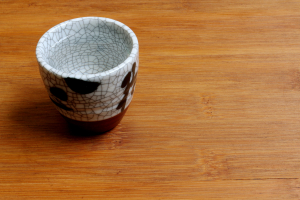
Now, let’s take a closer look at the differences in the sake vessels. Sake vessels we are the most familiar with are the ochoko and guinomi. To put it simply, the difference between the two is the size.
The capacity of the ochoko is the amount that can be drunk is a single, whereas the amount in the guinomi is slightly larger. There is no “exact” measurement for either, so we ask you to examine your drinking style for your selection.
And though it doesn’t really fit into the category of sake vessels, for Sake lovers, we would like to mention the soba choko. Reasonably sized, this is a convenient ite, for Sake lovers who find it bothersome to pour Sake into the container multiple times. The size is not too large so Sake lovers need not worry about Sake changing its temperature.
The Difference between tokkuri and katakuchi
Next, we will look at not the sake vessel we drink from, but the sake vessel Sake is first poured into: the Sake servers, the tokkuri and katakuchi. We can easily see the difference in the size of the openings, between the two. The tokkuri’s opening is small but the katakuchi’s opening is on the larger side.
As stated, the larger opening enhances the Sake’s aroma. In general, for aroma, Sake is poured into the katakuchi. To enjoy the deep flavors, most select the tokkuri.
Following this rule, the best shape for hot Sake is the tokkuri. When Sake lovers wish to savor the mellow flavor from hot Sake, the tokkuri is the recommended.
Though there are many saying about the tokkuri, there is no clear evidence of its authenticity. We do know the sake vessel name tokkuri was given from the “to-kuri, to-kuri” sound Sake makes when it was poured. It is said the name was decided first with the kanji assignment occurring on a later date.
The Enjoyment of a different type of sake vessel
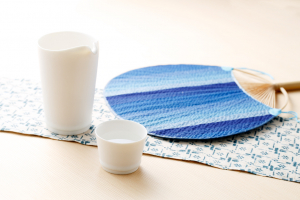
We have explained the differences in the materials, the size of the openings, the flavor as well as how to maximize (or minimize) the aroma from Sake using various sake vessels. Now that we have discussed the basics, let’s have some fun trying some unusual types of sake vessels.
Within sake vessels, there are traditional designs as well as sake vessels of other styles and designs. A good example is the sake vessel with the ice pocket. Perfect for cold Sake, this sake vessel allows the Sake to remain at its cold temperature by having a pocket for ice.
And there are sake vessels whose designs are neither katakuchi nor tokkuri. So, though we would like Sake lovers to have a great Sake experience, do not restrict your enjoyments by strictly following the rules. Knowledge is important but ultimately, personal preference should play a major factor in the selection of sake vessels.
Off Topic: How to drink Mokkiri
The practice of placing a sake glass in a masu, and then having Sake so generously poured that it overflows into the masu is known as mokkiri. If you are aware of this Sake practice, congratulations! However, most Sake lovers become overwhelmed at this sight of Sake in both the sake glass and masu. What is the procedure? Let us explain.
There are no rules on how to drink
Actually, there are no official rules on how to drink the mokkiri way. You can drink from the sake glass, you can drink from the masu. Either is fine. However, depending on the order, the flavor of the Sake will be slightly different.
If you drink Sake from the masu, you are able to enjoy the flavor of the Sake. With the large opening, you are able to enjoy the aroma as well.
On the other hand, if you drink from the sake glass, and then add the Sake from the masu into the glass, you can taste a slightly woody flavor. And depending on your mood, the type of Sake, it may be fun to try different combinations to discover new ways to enjoy Sake.

